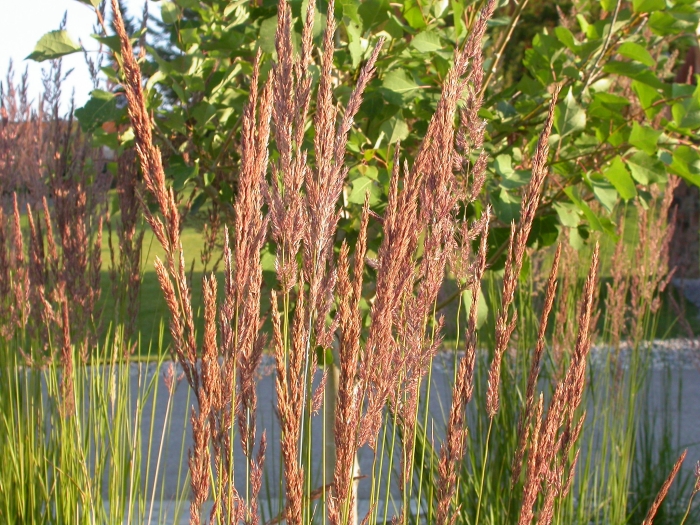Feather Reed Grass
(Calamagrostis acutiflora)
Feather Reed Grass (Calamagrostis acutiflora)
/
/

Matt Lavin
CC BY-SA 2.0
Image By:
Matt Lavin
Recorded By:
Copyright:
CC BY-SA 2.0
Copyright Notice:
Photo by: Matt Lavin | License Type: CC BY-SA 2.0 | License URL: https://creativecommons.org/licenses/by-sa/2.0/ | Uploader: Matt Lavin | Publisher: Flickr |






















Estimated Native Range
Summary
Calamagrostis acutiflora, commonly known as Feather Reed Grass, is a deciduous or semi-deciduous perennial grass native to open woodlands and wet meadows in Europe and Asia. It is a naturally occurring hybrid of the species C. arundinacea and C. epigejos. Feather Reed Grass typically grows to a height of 2-5 feet and a width of 1-3 feet, featuring a clumping habit with upright, feathery flower plumes that emerge in early summer. The flowers are initially purplish-green, turning golden as seeds mature. This grass is particularly noted for its vertical form and for the feathery inflorescences that sway gracefully in the breeze.
Feather Reed Grass is valued for its low maintenance, adaptability, and the architectural quality it adds to landscapes. It is often used in ornamental borders, as a privacy screen, and in mass plantings. It thrives in full sun but can tolerate light shade and prefers consistently moist, well-drained soil. The cultivar ’Karl Foerster’ is especially popular for its early bloom time and resistance to flopping, earning the Royal Horticultural Society’s Award of Garden Merit. While generally disease-free, it can suffer from rust in humid conditions and may require division every few years to maintain vigor. It is not known for aggressive roots or invasiveness.CC BY-SA 4.0
Feather Reed Grass is valued for its low maintenance, adaptability, and the architectural quality it adds to landscapes. It is often used in ornamental borders, as a privacy screen, and in mass plantings. It thrives in full sun but can tolerate light shade and prefers consistently moist, well-drained soil. The cultivar ’Karl Foerster’ is especially popular for its early bloom time and resistance to flopping, earning the Royal Horticultural Society’s Award of Garden Merit. While generally disease-free, it can suffer from rust in humid conditions and may require division every few years to maintain vigor. It is not known for aggressive roots or invasiveness.CC BY-SA 4.0
Plant Description
- Plant Type: Grass
- Height: 2-5 feet
- Width: 1-3 feet
- Growth Rate: Moderate
- Flower Color: N/A
- Flowering Season: Spring, Summer
- Leaf Retention: Deciduous
Growth Requirements
- Sun: Full Sun
- Water: Medium, High
- Drainage: Medium
Common Uses
Bank Stabilization, Bird Garden, Border Plant, Butterfly Garden, Deer Resistant, Drought Tolerant, Erosion Control, Groundcover, Low Maintenance, Potted Plant, Rabbit Resistant, Rock Garden, Salt Tolerant, Street Planting
Natural Habitat
native to open woodlands and wet meadows in Europe and Asia
Other Names
Common Names:
Scientific Names: Calamagrostis acutiflora , Calamagrostis ×acutiflora , Calamagrostis subulata , Calamagrostis yatabei , Arundo acutiflora , Deyeuxia acutiflora , Arundo ×splendida , Arundo ×subulata , Arundo pseudoarundinacea , Arundo varia var. acutiflora
GBIF Accepted Name: Calamagrostis acutiflora (Schrad.) DC.